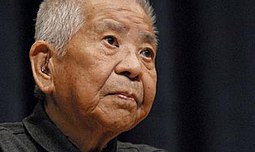This is an old revision of this page, as edited by Andrea105 (talk | contribs) at 03:46, 14 December 2009 (Reverted edits by 68.34.233.195 (talk) to last version by 24.148.172.219). The present address (URL) is a permanent link to this revision, which may differ significantly from the current revision.
Revision as of 03:46, 14 December 2009 by Andrea105 (talk | contribs) (Reverted edits by 68.34.233.195 (talk) to last version by 24.148.172.219)(diff) ← Previous revision | Latest revision (diff) | Newer revision → (diff)| Tsutomu Yamaguchi | |
|---|---|
 Tsutomu Yamaguchi Tsutomu Yamaguchi | |
| Born | (1916-03-16) 16 March 1916 (age 108) |
| Occupation | Retired Engineer |
| Children | Toshiko Yamaguchi, Katsutoshi Yamaguchi, Naoko Yamaguchi |
Template:Japanese name Tsutomu Yamaguchi (山口 彊, Yamaguchi Tsutomu) (born March 16, 1916), a Japanese man, is one of the few people to survive both the Hiroshima and Nagasaki atomic bombings. He had already been listed as a hibakusha (explosion-affected person) of the August 9 Nagasaki bombing, but on March 24, 2009 the government of Japan officially certified that he had also been in Hiroshima on a business trip during the first atomic bombing.
Background
Yamaguchi, an engineer in Hiroshima on a business trip for Mitsubishi Heavy Industries on August 6, 1945 was just stepping off a tram when the atomic bomb Little Boy was dropped over the city just 3 kilometers away. The resulting explosion destroyed his eardrums, blinded him temporarily, and left him with serious burns over the left side of the top half of his body. He was wrapped in bandages for his skin wounds, and he went completely bald. Like many of the survivors of the atomic explosions, Yamaguchi suffered from effects caused by the explosions for much of his life. His wife was also poisoned by the nuclear fallout. Yamaguchi spent a fitful night in an air raid shelter before returning to his hometown of Nagasaki the following day. Yamaguchi was once again 3 kilometers away explaining to his supervisor how close he came to death just a few days before when the second bomb, Fat Man, was dropped.
Later life
As of 2009, Yamaguchi is fighting cancer possibly caused by exposure to the bomb radiations. In his eighties, he wrote a book about his experiences and was invited to take part in a 2006 documentary about 165 double A-bomb victims called Nijuuhibaku ("Twice Bombed"), which was screened at the United Nations. He is an active anti-nuclear protester and has urged the United Nations General Assembly to ban all nuclear weapons. He has been recognized by Cracked.com, a popular American humor website, as the Unluckiest Person Ever.
Yamaguchi has become a vocal proponent of nuclear disarmament. In an interview he said "The reason that I hate the atomic bomb is because of what it does to the dignity of human beings."
Remarks
- Concerning his recognition, he was quoted as saying, "My double radiation exposure is now an official government record. It can tell the younger generation the horrifying history of the atomic bombings even after I die."
- "I can't understand why the world cannot understand the agony of the nuclear bombs," he says, speaking through his daughter. "How can they keep developing these weapons?"
- "It was my destiny that I experienced this twice and I am still alive to convey what happened."
See also
External links
- The Luckiest or Unluckiest Man in the World? Tsutomu Yamaguchi by Richard Lloyd Parry, The Times, March 25 2009
- Survivor of Hiroshima and Nagasaki talks to AM, by Mark Willacy, AM, May 19 2009
References
- "Elderly man officially recognized as double hibakusha"
- "Japanese man certified as double A-bomb victim"
- "Man survived both atomic bombings"
- Richard Lloyd Parry (August 6, 2005). "To hell and back". The Times. Retrieved 2009-03-28.
- ^ McNeill, David (26 March 2009). "How I survived Hiroshima – and then Nagasaki". The Independent. Retrieved 2009-03-26.
- A little deaf in one ear - meet the Japanese man who survived Hiroshima and Nagasaki
- "Twice Bombed, Twice Survived: Film Explores Untold Stories from Hiroshima & Nagasaki". Columbia University. August 2, 2006. Retrieved 2009-03-31.
- ^ Robbins, Micheal W., ed. (2009). "Japanese Engineer Survived Atomic Strike on Hiroshima- and Nagasaki". Military History Magazine. 26 (5). Wieder History Group: 8.
{{cite journal}}: Unknown parameter|month=ignored (help) - http://www.msnbc.msn.com/id/29865222